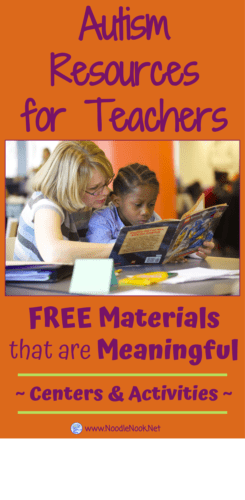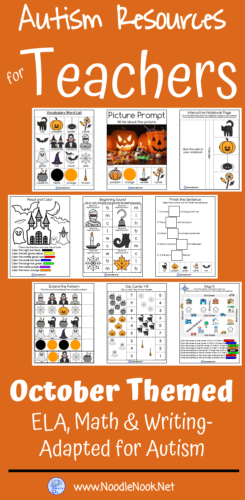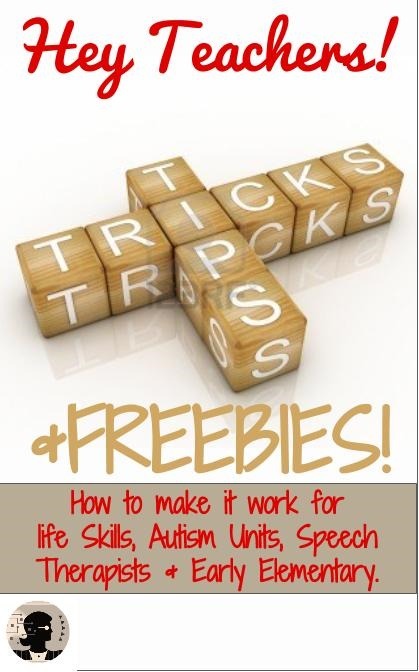Autism Resources for Teachers
Meaningful materials that have been leveled for students working on prerequisite skills, like those in Autism Units and LIFE Skills, are hard to come by. There are some expensive subscriptions you can shell out for, but what if you’re not loaded? Where can you find the things you need? And what are the things you really need?
 Themed Units from the Classroom
Themed Units from the Classroom
I have had some struggles in the classroom… trying to find things that will work with my higher academic students as well as my lower academic students- and all while staying on the same topic or theme. That’s where the idea for Academically Themed Units came from.
I have been in the classroom with new teachers who’ve been having the same troubles. Where do I get meaningful materials that are no prep? How can you differentiate without having to remake materials? It is hard to pull materials from all over the place and make it work. I get that. So how can you do it?
 Big Ideas for English
Big Ideas for English
The National Reading Panel has highlight pillars of literacy necessary for developing reading skills. They include phonics, comprehension, vocabulary, and fluency. I also throw in writing because it is such an important part of society these days (I am reading and writing all day long via social media, text messages, and emails).
When it comes time to create meaningful Autism resources for teachers, there are a few things you want to touch on. These are not only great activities, but also make fabulous work boxes and centers.
English Resources for Autism Teachers
When it comes to Phonics, the focus is what sounds letters make, putting them together (blending) and breaking them up (segmenting). Phonics is the strongest indicator of overall reading ability. A lot of teachers, especially those in Autism Units and LIFE Skills focus a lot on trying to teach the names of letters. That may be a wasted effort. Knowing letter sounds is much more important in developing good reading skills.
PHONICS
As you work on Phonics, try to touch on the following:
- Beginning Sound & Ending Sound
- Blends & Segmenting
- Onset & Rimes
And this the Ultimate Phonics PRINTABLE- Everything you could need. Literally.
But if you also want more in terms of worksheets and teacher lesson plans, try this PRINTABLE.
As you work on Phonics, you may also find that you are inherently working on Vocabulary and Fluency too.
VOCABULARY
Vocabulary focuses on expanding the understanding of words. You may be able to address this with phonics as you work on words. You may also want to work on this with other tools like sight words. As you work on sight words, especially with students with disabilities, don’t just focus on saying words- students really have to understand their meaning. Use words on the following lists:
- Dolch Word List (This is a great FREE assessment with Data Sheets!)
- Fry Word List (Get a PRINTABLE word list for both Dolch & Fry HERE)
- Fountas & Pinnell Words (And a FREE Assessment is HERE)
[tweetthis]Awesome Materials for Autism Units- FREE and How to Use Them. LOVE![/tweetthis]
FLUENCY
Fluency is the ability to read words quickly, accurately, and with expression. Finding great and measurable passages that will generate data for you can be hard. But try this FREE PRINTABLE from the State of Florida.
Do you have robotic readers? Those who are able to word call, but not evoke feeling? You may have to model this a lot to get a students to learn how to emote in reading while showing how to chunk two or three words together at once. Repeated reading also works well with students who are robotic in reading. Finally, don’t forget to use readers that are lower than the student’s actual reading level… that way the words are well known and more automatic.
COMPREHENSION
Comprehension is understanding the meaning and message in a reading passage. There are lots of ways to assess comprehension while reading, but I still find it a challenge when working with students who are nonverbal or echolalic. How do you overcome this? Be sure to add visuals to add context to the text as you are reading and be sure to add visuals to the comprehension process by allowing students to point or select their response from an array of images and/or words. You can read more HERE on comprehension with nonverbal students.
Graphic organizers are also a very effective tool in working on comprehension. Venn diagrams and T-Charts are super as tools to make concrete the ideas and information we read.
Here is a great assessment packet that addresses Fluency, Vocabulary, and comprehension with passages that have prepared questions. Or this one here for shorter packets. And don’t forget these printable graphic organizers HERE.
WRITING
Finally, Writing! With students with disabilities, I see a lot of people get caught up in the form of writing and not the function of writing. The form of writing is the function of holding a pencil and applying it to paper. It involves gross and fine motor skills to print or write in cursive. You remember all the penmanship writing we did growing up? Oi.
Function of writing is the process of putting ideas in print. This is the most important part of writing. Don’t get caught up in the form. Remember the function… now that is not to say ignore the form, but don’t sacrifice function for form.
Having said that, writing has to be incorporated into all aspects of your day and for as many purposes as possible. Find reasons to write and ways to express lots of ideas as much as possible.
Math Resources for Autism Teachers
One of the most popular posts on this blog this year is about FREE Printable Math Centers you can start today. Be sure to read it! And also check out the post on doing math with Nonverbal Students. Worth it!
 Putting it All Together
Putting it All Together
So do you want to hit on all the things mentioned for ELA and Math topics mentioned in prior posts, you may get an expensive subscription… but I do suggest you check out this October Themed Unit. A printable that covers ELA, math and writing. The preview will give you a table of contents that actually makes a great guide of activities to get into your classroom to make meaningful materials for your students with Autism.
Autism resources for teachers are hard to find- but the materials here should help. Good luck… and teach on!


Been doing this a few years and always looking for new tasks for my kiddos. This stuff is perfect- I already bought a few of the adapted books from TPT and they love those. Thanks for the posts, keep it up!
Just getting placed into a self-contained classroom. So glad to see all these activities for students like mine! Thanks!
Pingback: Homeschool Resources for Autistic Learners | A2Z Homeschooling
Comments are closed.